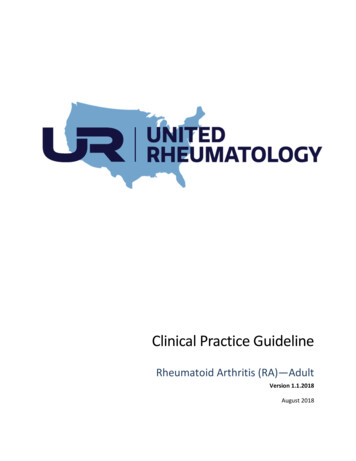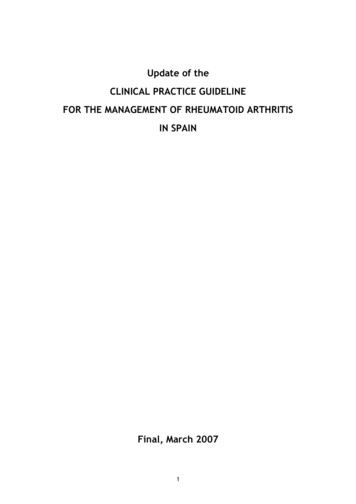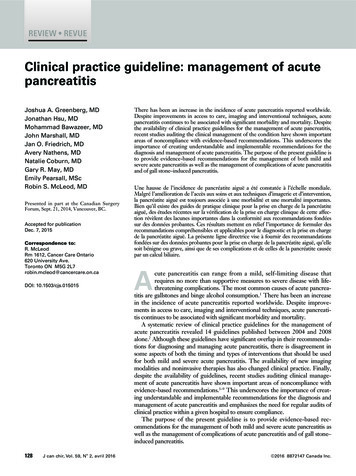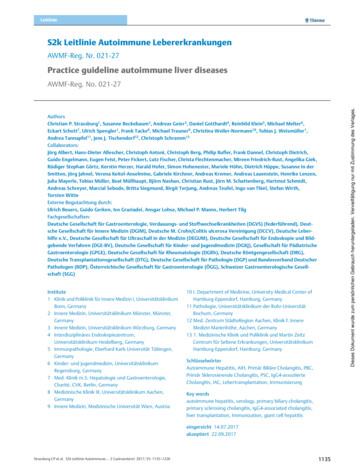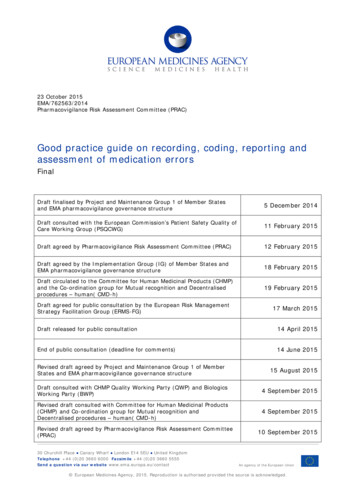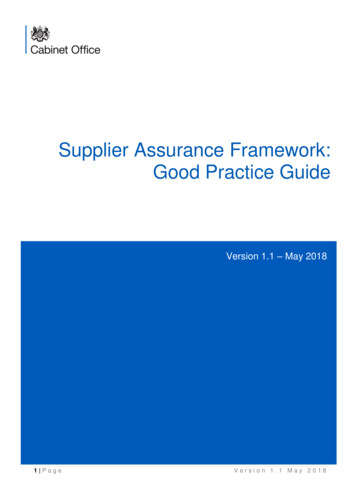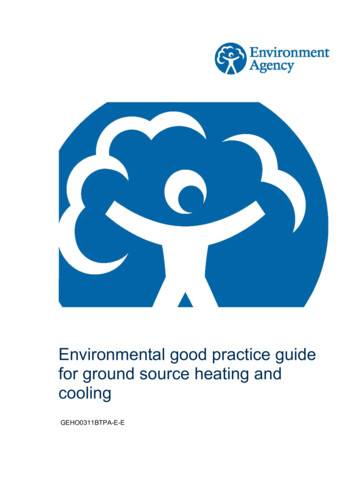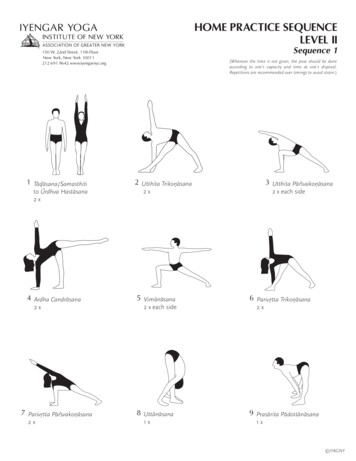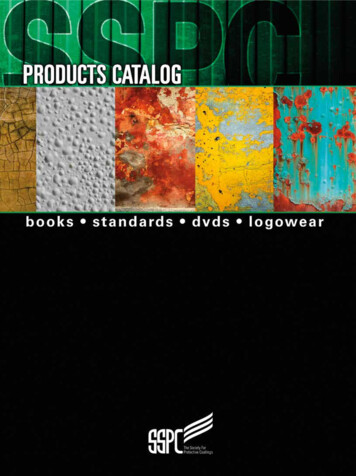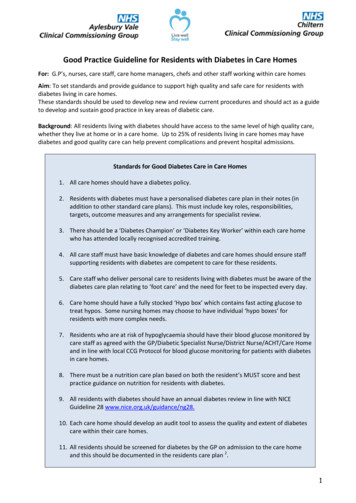
Transcription
Good Practice Guideline for Residents with Diabetes in Care HomesFor: G.P’s, nurses, care staff, care home managers, chefs and other staff working within care homesAim: To set standards and provide guidance to support high quality and safe care for residents withdiabetes living in care homes.These standards should be used to develop new and review current procedures and should act as a guideto develop and sustain good practice in key areas of diabetic care.Background: All residents living with diabetes should have access to the same level of high quality care,whether they live at home or in a care home. Up to 25% of residents living in care homes may havediabetes and good quality care can help prevent complications and prevent hospital admissions.Standards for Good Diabetes Care in Care Homes1. All care homes should have a diabetes policy.2. Residents with diabetes must have a personalised diabetes care plan in their notes (inaddition to other standard care plans). This must include key roles, responsibilities,targets, outcome measures and any arrangements for specialist review.3. There should be a ‘Diabetes Champion’ or ‘Diabetes Key Worker’ within each care homewho has attended locally recognised accredited training.4. All care staff must have basic knowledge of diabetes and care homes should ensure staffsupporting residents with diabetes are competent to care for these residents.5. Care staff who deliver personal care to residents living with diabetes must be aware of thediabetes care plan relating to ‘foot care’ and the need for feet to be inspected every day.6. Care home should have a fully stocked ‘Hypo box’ which contains fast acting glucose totreat hypos. Some nursing homes may choose to have individual ‘hypo boxes’ forresidents with more complex needs.7. Residents who are at risk of hypoglycaemia should have their blood glucose monitored bycare staff as agreed with the GP/Diabetic Specialist Nurse/District Nurse/ACHT/Care Homeand in line with local CCG Protocol for blood glucose monitoring for patients with diabetesin care homes.8. There must be a nutrition care plan based on both the resident’s MUST score and bestpractice guidance on nutrition for residents with diabetes.9. All residents with diabetes should have an annual diabetes review in line with NICEGuideline 28 www.nice.org.uk/guidance/ng28.10. Each care home should develop an audit tool to assess the quality and extent of diabetescare within their care homes.11. All residents should be screened for diabetes by the GP on admission to the care homeand this should be documented in the residents care plan 2.1
Key Roles and Responsibilities for Providing Care for Residents with Diabetes:Residential Care Homes Every resident with diabetes should have a detailed diabetes care plan which has been agreedwith the resident and GP. (See Appendix 2: Example of Diabetes Care Plan)Good diabetes care starts with a diabetes policy and all staff must read and be aware of thecare home diabetes policy.There should be a diabetes champion or key worker in each care home - this person shouldattend the locally recognised diabetes training and will be responsible for making sure eachresident with diabetes has a diabetes care plan with all the relevant sections completed. Theycan support all other care staff to provide high standards of diabetes care especially regardinggood foot care, nutrition and other elements of care depending upon each individual.The annual review for diabetes will be the responsibility of the GP who may delegate part ofthis to the District Nurses/Adult Community Health Team Nurse if the resident is classified asbeing housebound.Nursing Homes Every resident with diabetes should have a detailed diabetes care plan which has been agreedwith the resident and GP. (See Appendix 2: Example of Diabetes Care Plan)Good diabetes care starts with a diabetes policy and all staff must read and be aware of thepolicy.There should be a diabetes champion or key worker in each care home - this person shouldattend the locally recognised diabetes training and will be responsible for making sure eachresident has a diabetes care plan with all the relevant sections completed. They can supportall other care staff to provide high standards of diabetes care especially regarding foot care,nutrition and other elements of care depending upon each individualThe annual foot review should be completed by the GP, the care home nurse or other nurse(with required competencies) or a Health and Care Professions Council (HCPC) registeredChiropodist or Podiatrist.The Annual review will be the overall responsibility of the GP who may request that nurseswithin homes undertake some of the required checks. Nurses should ensure that they havethe skills and competency to complete these when requested.GP The resident’s GP is responsible for the diabetes annual review and reviewing medication atleast every year.The resident’s GP is responsible for offering pre-diabetes reviews in line with theBuckinghamshire pre-diabetes protocol.2
The following documents can support The Diabetes Care Plan and can be used to implement theminimum standards required for good diabetes care.Appendix 1 – Diabetes policy for care homesAppendix 2 – Example of a care planAppendix 3 – Diabetes annual reviewAppendix 4 – How to treat hypoglycaemia in care homesAppendix 5 – Hypo box for care homesAppendix 6 – Hypoglycaemia care planAppendix 7 – Hyperglycaemia care planAppendix 8 – Nutrition in diabetes informationAppendix 9 – Foot care risk assessmentAppendix 10 – Protocol for blood glucose monitoring (BGM) for patients with diabetes in care homesReferences:1. Good clinical practice guidelines for care home residents with diabetes - A revision documentprepared by a Task and Finish Group of Diabetes UK Us/Our%20views/Care%20recs/Care-homes0110.pdf2. Guidance for CQC staff: Inspecting the quality of care for residents with diabetes mellitus living incare es/3. Passport for Diabetes in Care Settings – Independent Diabetes Trust in partnership with theInstitute of Diabetes for Older People www.iddtinternational.org3
Appendix 1: Diabetes Policy for Care HomesAim: Every care home should have a detailed diabetes policy that all staff caring for residents withdiabetes should comply with. The diabetes policy should meet the minimum standards set out within thisdocument; in addition care homes may consider including the following information depending upon ontheir specific local circumstances. The care home should ensure that their own diabetes policy meets theneeds of their residentsWhat to include in a diabetes policy:Both the Diabetes UK 1 and the Care Quality Commission (CQC)2 have clinical practice guidance for carehome residents.Clinical practice guidelines - to include:Dealing with illnessDiabetes and es/Living with diabetes/Illness/See Appendix 7www.trenduk.org/documents/Diabetes And Dementia Guidance.pdfA screening programme for diabetesResident’s care planTreatment goal settingManagement of hypoglycaemiaSee Appendix 4 and Appendix 6Availability of hypoglycaemia kit (hypobox)See Appendix 5Blood glucose monitoringSee Appendix 10Administration of treatments includinginsulinAnnual review arrangements to includeeye screeningSee Appendix 3Dietary and nutritional policySee Appendix 8Liaison with community diabetesservicesDaily foot care and access to servicesSee Appendix 9Regular audit of services which couldinclude referral to hospitalSupporting staff to deliver effectivediabetes care- access to education andtraining4
Appendix 2: Example of a Diabetes Care PlanPatients Name:Date of Birth:Diabetes – Type 1 or Type 2Diabetes Champion in Care Homename:These health professionals areinvolved in my diabetes care e.g.Diabetes Specialist Nurse, PracticeNurse, Consultant, Podiatrist,Dietitian, Ophthalmologist?Name:Job title:Contact Number:Name:Job title:Contact Number:Name:Job title:Contact Number:* Care homes can either use the above template or their own diabetes/standard care plans as long as all relevant sections are includedAs part of my diabetes care I have targets and need care plans for the following:NutritionMobilityFoot careSkin CareOtherContinenceImportant DatesI need a diabetes annual reviewDates of diabetes annual review:every year – please arrange this withmy GPManaging my diabetes:I have type diabetes. This is managed by: Insulin and Diet Insulin, Tablets and Diet Diet and Tablets Diet Only Other (please state)Please refer to my Medication Administration Record (MAR) sheet for further details of my diabetesmedicationAt times my blood sugar levels may be too low (hypoglycaemia or Hypo) or too high (hyperglycaemia orHyper).If I am on insulin or sulphonylureas (e.g. gliclazide), my blood glucose levels may need to be monitored.Please refer to the local CCG Protocol for blood glucose monitoring. I need additional care plans if I amat risk of either of these – ask my GP/Diabetic Specialist Nurse/Nurse/ Pharmacist if in doubt.Blood glucose range for individual resident as agreed byGP/Diabetic Specialist NurseIndividual target range:(Acknowledgements go to the Independent Diabetes Trust in partnership with the Institute of Diabetes for Older People whoprovided the basis for this template)5
Appendix 3: Annual Review for Every Resident Living with DiabetesAim: Every resident living with diabetes should have an annual medical review of their diabetes in eithertheir GP surgery or in their care home The residents GP practice is responsible for providing their diabetes annual review The date of the review and where the review will take place must be recorded in the resident’sdiabetes care planInformation required for an annual diabetes review:At or before the annual review the GP will need the following information:Weight record, current Malnutrition Universal Screening Tool (MUST) risk (score) andDietNutrition care planBP readingsA record of all blood and urine testsMonitoringA urine specimen (ACR urine test) should be requested and a special container will beresultsrequired. The GP practice will be able to advise on these requirements.A blood test may be requested 1-2 weeks prior to the reviewMedicationA copy of the current Medication Administration Record (MAR) sheetFoot CheckThe Annual foot check is an essential part of the annual review. More information isavailable .pdfGeneralConditionInformation about any change in resident’s medical condition since their last reviewConsider asking the GP for an additional review and/or medication review if: Resident is losing weight and MUST score is 2 or above (high risk)Resident has episodes of hypoglycaemia or hyperglycaemiaResident’s health has declined(other changes that may also require a review)More information regarding diabetes treatment in older people can be found at:www.chilternccg.nhs.uk/practices/bpcc/Chiltern CCG Diabetes Bulletin Issue21 Oct2015.pdfDiabetes and End of life:Information regarding the care of residents with diabetes at end of life can be found below. Earlyreferral to the resident’s GP or Diabetic Specialist Nurse (DSN) is an important pdfwww.trend-uk.org/documents/End of Life%20clinical%20recommendations.pdfEnsure that the date of the annual review is recorded within the care plan.6
Appendix 4: How to Treat Hypoglycaemia (Hypo’s) in Care Homes7
8
Appendix 5: Hypo Box (Kit) - Guidance for Care HomesAim:All care homes that care for residents living with diabetes should keep a fully stocked ‘hypo’ box that isavailable to treat residents who experience low blood glucose (hypo).All staff should know the location of the hypo box and it should be easily accessible to trained staff atall times.What is a hypo box?A hypo box is a box containing several suitable sources of fast acting glucose which is available to begiven to residents* who are experiencing an episode of low blood glucose (hypo). This should be usedin line with the ‘hypoglycaemia in care homes guideline’ and the individual resident’s diabetes careplan.(* Residents with diagnosed dysphagia (swallowing difficulties) who require thickened drinks and/or asoft or pureed diet will need a specialist care plan regarding treatment of hypos)Contents of the Hypo BoxIt is the responsibility of the care home to purchase a plastic box and the required glucose products tomake their own ‘Hypo Box’. These items are available at large supermarkets and /or local pharmacies.It may be useful to have a liquid measure available with the box.Suggested products to include in a hypo box include:Non-diet fizzy drink, carton of smooth orange juice, GlucoTabs R, Dextrose tablets, jelly babies. Followthe hypoglycaemia guideline for actual amounts of glucose to be given.Maintenance of the hypo box:There must be a process within the care home to: Check that each item within the box is in date on a monthly basis or more often if applicable Any item that has been opened for use must then be discarded and replaced Ensure that each care plan states the resident’s preference of product, e.g. would they prefer aglucose drink or sweets? Expiry dates should be clearly marked on the exterior of the hypo box Depending upon the size of the home it may be useful to have more than one Hypo Box e.g. onehypo box per floorImage of a ‘hypo’ box9
Appendix 6: Hypoglycaemia (Hypo) Care Plan*Patients Name:Date of Birth:Diabetes Key Worker:When to contact the GP* Care homes can either use the above template or their own diabetes/standard care plans as long as allrelev
5. Care staff who deliver personal care to residents living with diabetes must be aware of the diabetes care plan relating to Zfoot care [ and the need for feet to be inspected every day. 6. Care home should have a fully stocked Hypo box which contains fast acting glucose to treat hypos. Some nursing homes may choose to have individual hypo .
